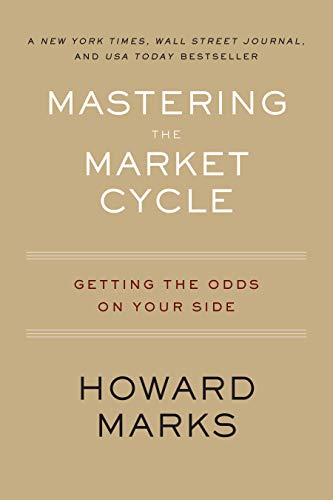Mastering The Market Cycle: Getting the Odds on Your Side
A NEW YORK TIMES, WALL STREET JOURNAL, AND USA TODAY BESTSELLER
The legendary investor shows how to identify and master the cycles that govern the markets.
We all know markets rise and fall, but when should you pull out, and when should you stay in? The answer is never black or white, but is best reached through a keen understanding of the reasons behind the rhythm of cycles. Confidence about where we are in a cycle comes when you learn the patterns of ups and downs that influence not just economics, markets, and companies, but also human psychology and the investing behaviors that result.
If you study past cycles, understand their origins and remain alert for the next one, you will become keenly attuned to the investment environment as it changes. You’ll be aware and prepared while others get blindsided by unexpected events or fall victim to emotions like fear and greed.
By following Marks’s insights—drawn in part from his iconic memos over the years to Oaktree’s clients—you can master these recurring patterns to have the opportunity to improve your results.
From the Publisher


A Note to Readers from Howard Marks, author of Mastering the Market Cycle
Investors clearly could do much better if they knew what lies ahead. But they can’t. Few people can accurately predict what the future holds in store for the economy and markets, and fewer still know enough about these things to out-think and thus out-invest the general consensus of investors whose views are incorporated into – ‘discounted by’ – the market prices of securities. But we know economies and markets follow an up-and-down pattern called a cycle and, importantly, knowing where we currently stand with regard to the economic cycle and the market cycle can give us a better idea of what lies ahead. This is a process through which investors can get the odds on their side.
When the economy is just beginning to recover from a slowdown and the markets are picking themselves up off the floor after a bust, it’s highly likely that security prices haven’t been lifted to precarious levels by large doses of investor optimism.
Pleasant surprises are more likely to lie ahead than disappointments; investors will probably come to be persuaded of these things over time and thus become buyers; and their buying should cause security prices to rise. At such a point – when economies and markets are low in their cycles – good things are more likely to lie ahead than bad things.
Since security prices aren’t inflated, buying at that point is likely to make for significant appreciation and entail little risk.
And on the contrary, when the recovery and bull market have been rolling for a while, investors are likely to be feeling good, and their optimism is likely to be incorporated in security prices.


Thus prices may be at risky highs; disappointments are more likely to lie ahead than good news; and thus risk may be high and appreciation hard to come by. All these things mean that when we’re high in the cycle, the odds are against you. When others feel good and drive prices to highs, it’s time to cut risk and take some of your money off the table.
In all these things, the operative words are ‘likely’ and probable.’ So while we can’t know what the future holds, we can have a better idea whether the wind is at our back or in our face. The best investors have a sense for where we stand in the cycle and thus whether it’s time to build more aggressiveness or more defensiveness into their portfolios. This book will teach you what cycles are, what causes their rise and fall, and thus how to tell what investment moves are most likely to succeed.
ASIN : B078977BRM
Publisher : Mariner Books; Reprint edition (October 2, 2018)
Publication date : October 2, 2018
Language : English
File size : 4540 KB
Text-to-Speech : Enabled
Screen Reader : Supported
Enhanced typesetting : Enabled
X-Ray : Enabled
Word Wise : Enabled
Sticky notes : On Kindle Scribe
Print length : 350 pages
$15.99
Price: $15.99
(as of Sep 18, 2023 11:23:31 UTC – Details)
A NEW YORK TIMES, WALL STREET JOURNAL, AND USA TODAY BESTSELLER
The legendary investor shows how to identify and master the cycles that govern the markets.
We all know markets rise and fall, but when should you pull out, and when should you stay in? The answer is never black or white, but is best reached through a keen understanding of the reasons behind the rhythm of cycles. Confidence about where we are in a cycle comes when you learn the patterns of ups and downs that influence not just economics, markets, and companies, but also human psychology and the investing behaviors that result.
If you study past cycles, understand their origins and remain alert for the next one, you will become keenly attuned to the investment environment as it changes. You’ll be aware and prepared while others get blindsided by unexpected events or fall victim to emotions like fear and greed.
By following Marks’s insights—drawn in part from his iconic memos over the years to Oaktree’s clients—you can master these recurring patterns to have the opportunity to improve your results.
From the Publisher


A Note to Readers from Howard Marks, author of Mastering the Market Cycle
Investors clearly could do much better if they knew what lies ahead. But they can’t. Few people can accurately predict what the future holds in store for the economy and markets, and fewer still know enough about these things to out-think and thus out-invest the general consensus of investors whose views are incorporated into – ‘discounted by’ – the market prices of securities. But we know economies and markets follow an up-and-down pattern called a cycle and, importantly, knowing where we currently stand with regard to the economic cycle and the market cycle can give us a better idea of what lies ahead. This is a process through which investors can get the odds on their side.
When the economy is just beginning to recover from a slowdown and the markets are picking themselves up off the floor after a bust, it’s highly likely that security prices haven’t been lifted to precarious levels by large doses of investor optimism.
Pleasant surprises are more likely to lie ahead than disappointments; investors will probably come to be persuaded of these things over time and thus become buyers; and their buying should cause security prices to rise. At such a point – when economies and markets are low in their cycles – good things are more likely to lie ahead than bad things.
Since security prices aren’t inflated, buying at that point is likely to make for significant appreciation and entail little risk.
And on the contrary, when the recovery and bull market have been rolling for a while, investors are likely to be feeling good, and their optimism is likely to be incorporated in security prices.


Thus prices may be at risky highs; disappointments are more likely to lie ahead than good news; and thus risk may be high and appreciation hard to come by. All these things mean that when we’re high in the cycle, the odds are against you. When others feel good and drive prices to highs, it’s time to cut risk and take some of your money off the table.
In all these things, the operative words are ‘likely’ and probable.’ So while we can’t know what the future holds, we can have a better idea whether the wind is at our back or in our face. The best investors have a sense for where we stand in the cycle and thus whether it’s time to build more aggressiveness or more defensiveness into their portfolios. This book will teach you what cycles are, what causes their rise and fall, and thus how to tell what investment moves are most likely to succeed.
ASIN : B078977BRM
Publisher : Mariner Books; Reprint edition (October 2, 2018)
Publication date : October 2, 2018
Language : English
File size : 4540 KB
Text-to-Speech : Enabled
Screen Reader : Supported
Enhanced typesetting : Enabled
X-Ray : Enabled
Word Wise : Enabled
Sticky notes : On Kindle Scribe
Print length : 350 pages






